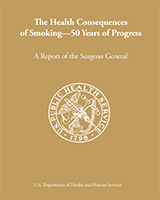NCBI Bookshelf. A service of the National Library of Medicine, National Institutes of Health.
National Center for Chronic Disease Prevention and Health Promotion (US) Office on Smoking and Health. The Health Consequences of Smoking—50 Years of Progress: A Report of the Surgeon General. Atlanta (GA): Centers for Disease Control and Prevention (US); 2014.

The Health Consequences of Smoking—50 Years of Progress: A Report of the Surgeon General.
Show detailsfrom the Acting Surgeon General, U.S. Department of Health and Human Services
On January 11, 1964, Luther L. Terry, M.D., the 9th Surgeon General of the United States, released the first report on the health consequences of smoking: Smoking and Health: Report of the Advisory Committee of the Surgeon General of the Public Health Service. That report marked a major step to reduce the adverse impact of tobacco use on health worldwide.
Over the past 50 years, 31 Surgeon General's reports have utilized the best available evidence to expand our understanding of the health consequences of smoking and involuntary exposure to tobacco smoke. The conclusions from these reports have evolved from a few causal associations in 1964 to a robust body of evidence documenting the health consequences from both active smoking and exposure to secondhand smoke across a range of diseases and organ systems.
The 2004 report concluded that smoking affects nearly every organ of the body, and the evidence in this report provides even more support for that finding. A half century after the release of the first report, we continue to add to the long list of diseases caused by tobacco use and exposure to tobacco smoke. This report finds that active smoking is now causally associated with age-related macular degeneration, diabetes, colorectal cancer, liver cancer, adverse health outcomes in cancer patients and survivors, tuberculosis, erectile dysfunction, orofacial clefts in infants, ectopic pregnancy, rheumatoid arthritis, inflammation, and impaired immune function. In addition, exposure to secondhand smoke has now been causally associated with an increased risk for stroke.
Smoking remains the leading preventable cause of premature disease and death in the United States. The science contained in this and prior Surgeon General's reports provide all the information we need to save future generations from the burden of premature disease caused by tobacco use. However, evidence-based interventions that encourage quitting and prevent youth smoking continue to be underutilized. This report strengthens our resolve to work together to accelerate and sustain what works—such as hard-hitting media campaigns, smokefree air policies, optimal tobacco excise taxes, barrier-free cessation treatment, and comprehensive statewide tobacco control programs funded at CDC-recommended levels. At the same time, we will explore “end game” strategies that support the goal of eliminating tobacco smoking, including greater restrictions on sales. It is my sincere hope that 50 years from now we won't need another Surgeon General's report on smoking and health, because tobacco-related disease and death will be a thing of the past. Working together, we can make that vision a reality.
- Boris D. Lushniak, M.D., M.P.H.Rear Admiral, U.S. Public Health ServiceActing Surgeon GeneralU.S. Department of Health and Human Services
- Preface - The Health Consequences of Smoking—50 Years of ProgressPreface - The Health Consequences of Smoking—50 Years of Progress
Your browsing activity is empty.
Activity recording is turned off.
See more...